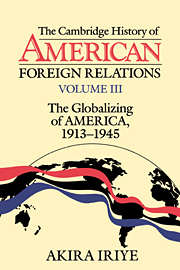Book contents
- Frontmatter
- 1 The age of European domination
- 2 The Great War and American neutrality
- 3 The United States at war
- 4 The Versailles peace
- 5 The 1920s: the security aspect
- 6 The 1920s: the economic aspect
- 7 The 1920s: the cultural aspect
- 8 The collapse of international order
- 9 Totalitarianism and the survival of democracy
- 10 The emergence of geopolitics
- 11 The road to Pearl Harbor
- 12 The global conflict
- Bibliographic Essay
- Index
- THE CAMBRIDGE HISTORY OF AMERICAN FOREIGN RELATIONS
- References
7 - The 1920s: the cultural aspect
Published online by Cambridge University Press: 28 March 2008
- Frontmatter
- 1 The age of European domination
- 2 The Great War and American neutrality
- 3 The United States at war
- 4 The Versailles peace
- 5 The 1920s: the security aspect
- 6 The 1920s: the economic aspect
- 7 The 1920s: the cultural aspect
- 8 The collapse of international order
- 9 Totalitarianism and the survival of democracy
- 10 The emergence of geopolitics
- 11 The road to Pearl Harbor
- 12 The global conflict
- Bibliographic Essay
- Index
- THE CAMBRIDGE HISTORY OF AMERICAN FOREIGN RELATIONS
- References
Summary
Peace as an ideology
Peace as a dominant idea was a distinctive feature of the postwar decade. This is not to say that there had been no forceful movements for peace or effective presentations of ideas of peace before then. Before the Great War, there had developed various strands of pacifism, ranging from traditional Christian conceptions to the more recent socialist formulations. In the United States, scores of peace societies had been established to organize the international community better to promote a stable, interdependent world order. And then, during the war, Woodrow Wilson and V. I. Lenin had emerged as spokesmen for two contrasting ideas about international affairs and propounded their respective visions of a world without war.
It was after 1919, however, that the idea of peace, of whatever shade of meaning, came to hold center stage in discussions about international affairs. We have already seen how potent were the drives for disarmament, outlawry of war, economic stabilization, and American capital movements, which together created an environment more conducive to peaceful interconnections among nations than to war and military preparedness. But the phenomenon had deep cultural roots as well and was sustained by intellectual developments in the 1920s. One might think of the ideology of peace at that time as a “hegemonic ideology” – the term Antonio Gramsci, the Italian Marxist, began to use as he penned his thoughts in prison. According to him, a society was held together through a set of ideas produced, refined, and manipulated by its elites in order to maintain some sort of order and cohesiveness.
- Type
- Chapter
- Information
- The Cambridge History of American Foreign Relations , pp. 103 - 115Publisher: Cambridge University PressPrint publication year: 1993



